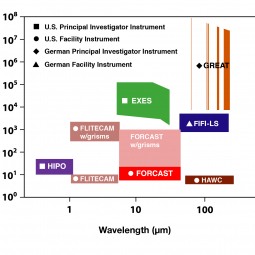The competition to develop a third generation instrument for the Stratospheric Observatory for Infrared Astronomy (SOFIA) has been narrowed to two proposed instruments. Over the course of the next few months, the two proposal teams will work to produce detailed concept studies. Based on those studies, one of those instruments will be selected to begin development by Fall 2016, with a targeted completion date in 2018. Both of the proposed instruments are intended to expand the SOFIA airborne observatory’s spectroscopic capabilities.
The first instrument proposal selected for a concept study was submitted by a team from the Jet Propulsion Laboratory in Pasadena, California, led by Paul Goldsmith. Goldsmith’s Stratospheric Heterodyne Array System for Terahertz Astronomy, (SHASTA), is designed to measure spectra of gas clouds within star-forming regions in the Milky Way and nearby galaxies to investigate how interstellar clouds form, and how stars subsequently form from those clouds.
SHASTA’s frequency band of 1.9 to 2.1 Terahertz (corresponding to a wavelength range of 143 to 158 microns) includes spectral lines of ionized carbon (C II), neutral atomic oxygen (O I), carbon monoxide (CO), and the methylidine radical (CH), plus the helium hydride ion (HeH+) that has not yet been detected in the interstellar medium. The Goldsmith team’s design for SHASTA has a detector consisting of 64 heterodyne pixels in a closely packed 8x8 configuration.
The second instrument proposal selected for a concept study was submitted by a team from NASA’s Goddard Space Flight Center in Greenbelt, Maryland, led by Harvey Moseley. Moseley’s High Resolution Mid-InfrarEd Spectrometer (HIRMES) is designed for high-resolution spectroscopy of protoplanetary disks at wavelengths between 28 and 112 microns.
HIRMES features long-slit spectral observing modes with resolving powers including R~600 for continuum spectroscopy, R~12,000 for multiple spectral lines, and up to R~100,000 for single lines. The proposed instrument’s characteristics are optimized to detect protoplanetary disk spectral lines from neutral atomic oxygen, water, and deuterated hydrogen molecules (HD).
Abstracts for both instruments can be read here .
The SOFIA program is a partnership of NASA and DLR. NASA's Ames Research Center located in Moffett Field, California manages the SOFIA science mission in cooperation with USRA, located in Columbia, Maryland, and DSI, located in Stuttgart, Germany. The SOFIA aircraft is based at the NASA Armstrong research aircraft operations facility in Palmdale, California.
